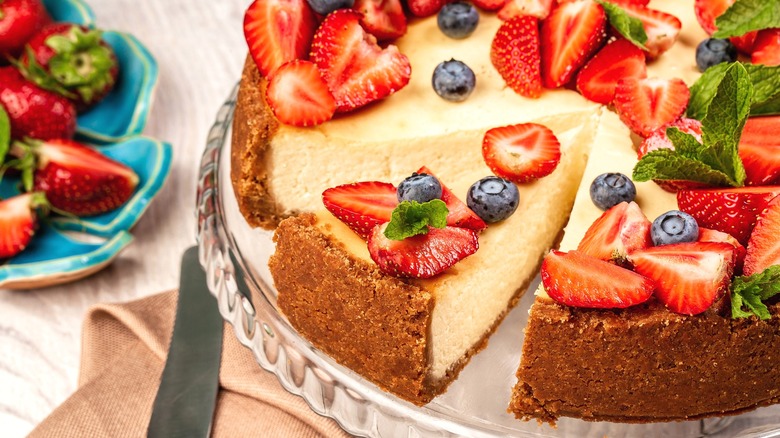Why It's So Important To Prebake Cheesecake Crust
Once you take the first bite, classic baked cheesecake often proves to be one of those desserts worth the extra time and effort spent in the kitchen. Ricotta or cream cheese is gently mixed into a balanced ratio of eggs and sugar to create a somewhat structured yet utterly creamy confection. Among the most essential elements of a solid cheesecake, a perfectly crisp yet tender crust transforms this luscious dessert into a multi-textured treat. Yet, how do you ensure your cheesecake base will have a perfectly desirable crumb?
Cheesecake crust can range from crushed graham crackers to pulverized cookies and butter and can even be made into more stable versions of some of your favorite desserts like sponge cake or brownies. In order to achieve distinct and easily decipherable layers of crust, filling, and any optional toppings, you want to prebake your crust to solidify its resulting composition.
By preparing your cheesecake crust in advance, which includes pressing the crumb mixture evenly around the edges of your spring form pan or pie dish and baking for a short time, you're indirectly safeguarding that bottom layer from the somewhat wet cream cheese and egg-based filling. When your mixture is baked, you'll have a soft and rich filling against a perfectly crisp crust. If you want your next cheesecake to have more distinct layers, how exactly do you prebake the crust for just the right amount of bite?
How to prebake cheesecake crust
Among the best tips you need to know before you bake another cheesecake, besides using room temperature ingredients and trying not to overbake this luscious dessert, parbaking your crust may be one necessary tip you hadn't even considered until now. If you love a perfectly textured exterior, prepare your favorite graham cracker, sugar, and butter mixture, pressing the ingredients evenly into your pan of choice. To ensure it sets evenly without becoming too hard during the baking process, press the mixture into the pan until all processed crumbs come together, but try to avoid packing the ingredients too firmly. While you can use your hands to achieve an even base layer, you can also use the bottom of a measuring cup.
Once your crust is neatly pressed into your pan of choice, simply bake in a 375-degree Fahrenheit oven for up to 10 minutes. This short stint in the oven helps solidify your cheesecake crust and closes off the top. This small amount of bake time also protects the base layer from becoming saturated from the raw cheesecake filling before and during the baking process. Just make sure you allow your parbaked crust to cool before adding the prepared cheese mixture. The result is a sweet and luscious cheesecake atop a distinguished uniform crust. Now that you know the benefits of prebaking your cheesecake crust, it's important to discern when you might choose to avoid the prebake method.
Not all cheesecake recipes require a prebaked crust
You may be left pondering whether or not your slightly boozy cherry cheesecake recipe really needs a prebaked crust. This decision not only comes down to personal choice, but there may be a few alternative crust ingredients to consider that don't necessarily require an extra jaunt in the oven. If you're making a standard graham cracker or cookie crust with added white sugar and butter, a bit of oven time may help bring your crust ingredients together. A crust made with ground nuts might also benefit from some extra oven time in order to achieve a nice roasted flavor.
However, if you plan on making a no-bake cheesecake, the usual egg-less filling of cream cheese, sugar, heavy cream, sour cream, and lemon juice can stand against an unbaked crust perfectly, given one suggested ingredient swap. Standard graham cracker crust is made with graham crackers, white sugar, and butter, but if you want to avoid any prebaking time, use brown sugar instead. Since brown sugar is made with molasses, this variety has a higher level of moisture, which nicely binds with graham crackers and butter without having to melt down before melding together in the oven. If you plan on making a no-bake cheesecake, skip the oven and make a brown sugar-based crust. However, for those of you after a traditional cheesecake, try prebaking your hand-crafted crust to achieve distinct textured layers in your next homemade dessert.


